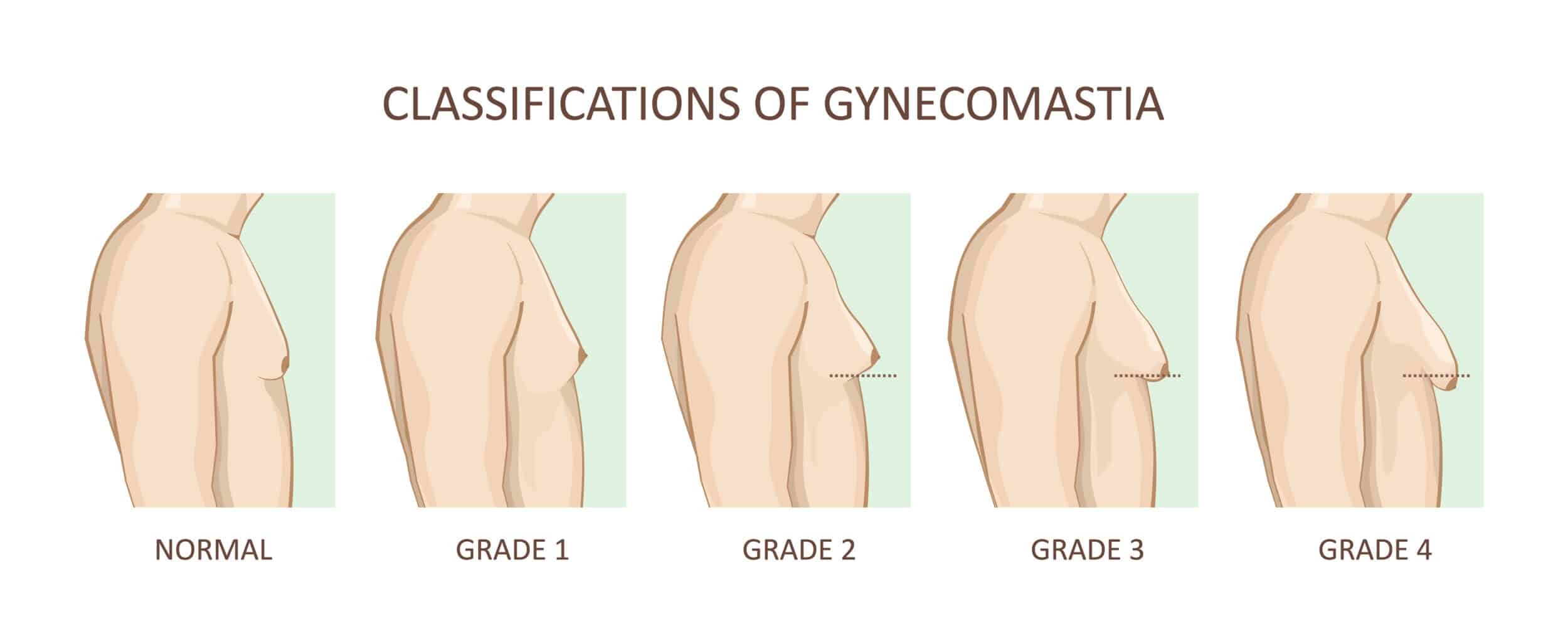Gynecomastia is a common condition that causes the enlargement of breast tissue in men, often leading to significant physical and emotional discomfort. Understanding the different grades and types of gynecomastia is crucial for addressing this issue.
Dr. Ronald H. Schuster, MD, a leading board-certified plastic surgeon in Baltimore, specializes in gynecomastia treatment and is dedicated to helping men regain their confidence and quality of life. Patients travel to his practice for his minimal scarring male breast reduction technique.
UNDERSTANDING GYNECOMASTIA
The most common cause of gynecomastia is thought to be a hormonal imbalance between estrogen and testosterone. However, the root issue is often unknown, which is why idiopathic gynecomastia is prevalent. Regardless of the cause, men with gynecomastia may experience tenderness, swelling, and enlargement of breast tissue, which can be both physically uncomfortable and emotionally distressing. It appears in various degrees of severity that are commonly referred to as grades.

GRADES OF GYNECOMASTIA
Gynecomastia can be categorized into different grades based on the severity of the condition:

GRADE 1: MINOR BREAST ENLARGEMENT
Grade 1 gynecomastia involves minor breast enlargement without excess skin. This grade is often less noticeable and may not cause significant discomfort. However, for those seeking a more defined chest appearance, treatment can still be beneficial. It can be treated with the lateral pull-through or lower peri-areolar approach.
GRADE 2: MODERATE BREAST ENLARGEMENT WITHOUT EXCESS SKIN
Grade 2 gynecomastia features moderate breast enlargement but does not involve excess skin. This grade is more noticeable and can impact self-esteem, especially in social or intimate situations. It can be treated with lateral pull-through or a lower peri-areolar approach.
GRADE 3: MODERATE BREAST ENLARGEMENT WITH EXCESS SKIN
Grade 3 gynecomastia includes moderate breast enlargement with excess skin. This grade can cause more pronounced physical changes and discomfort, often requiring surgical intervention to achieve optimal results. Usually needs a Peri-areolar skin excision and removal of fat and breast tissue.
GRADE 4: MARKED BREAST ENLARGEMENT WITH EXCESS SKIN
Grade 4 gynecomastia is characterized by significant breast enlargement and excess skin. This grade is the most severe and typically necessitates comprehensive surgical treatment to restore a natural and masculine chest contour. This is the most severe and requires a complete excision of skin and repositioning of the nipple as a nipple graft.
TYPES OF GYNECOMASTIA
Gynecomastia can manifest in various forms, each presenting unique challenges and requiring tailored treatment approaches. The following are the most common forms of gynecomastia.
PUFFY NIPPLES
Puffy nipples are a common manifestation of gynecomastia, particularly in mild cases. This type is characterized by a small amount of tissue beneath the nipple, leading to a protruding or puffy appearance. While it may not be as severe as other forms, puffy nipples can still affect a man's self-confidence.
PSEUDOGYNECOMASTIA
Pseudogynecomastia is caused by fat accumulation rather than glandular tissue. This type is often associated with weight gain and can be managed through lifestyle changes, such as diet and exercise, although surgical options are available for more effective results.
GLANDULAR GYNECOMASTIA
Both glandular and idiopathic gynecomastia involve the growth of glandular breast tissue, but the difference lies in the cause.
Idiopathic gynecomastia is the most common type and develops without a clear underlying reason. Hormone levels are typically normal, though genetics, environmental exposures, and diet may be contributing factors. It often appears during puberty and can include a mix of glandular and fatty tissue, varying in density.
Glandular gynecomastia has a known cause, often linked to hormonal imbalances, medications, or medical conditions. It can result from anabolic steroids, testosterone therapy, certain medications, tumors like prolactinomas, or endocrine disorders such as hyperthyroidism or liver disease. Obesity can also play a role by increasing estrogen levels, leading to glandular tissue growth.
TREATMENT OPTIONS
Addressing gynecomastia requires a personalized approach tailored to the specific grade and type of the condition. Treatment options include:
- Surgical Options: Liposuction, gland excision, and skin tightening are commonly used to treat gynecomastia. These surgical techniques aim to remove excess tissue and restore a natural chest contour.
- Non-Surgical Options: For some men, lifestyle changes and medications may help reduce breast tissue. However, these options are generally less effective for more severe cases.
Consulting with a specialist like Dr. Ronald H. Schuster, MD, ensures you receive a comprehensive evaluation and a treatment plan designed to meet your unique needs.
WHY CHOOSE DR. SCHUSTER?
Dr. Ronald H. Schuster stands out as a premier provider of aesthetic services in Maryland. With nearly 30 years of experience in plastic surgery, his extensive expertise and dedication to patient care make him an ideal choice for gynecomastia treatment.
Dr. Schuster is Board-Certified by the American Board of Plastic Surgery and serves as the immediate Past Chief of the Plastic Surgery Division at Northwest Hospital Center. He is a respected member of the American Society of Plastic Surgeons and the American Society of Aesthetic Plastic Surgery, prestigious organizations that set the highest standards for safety and excellence in plastic surgery.
Patients from all over the country seek Dr. Schuster's expertise, drawn by his reputation for outstanding results and compassionate care. He is an expert at the lateral pull-through technique when performing gynecomastia surgery, which results in the least possible amount of scarring and makes him a sought-after provider of male breast reduction treatment in the area.
Baltimore Magazine has repeatedly recognized him as a Top Doctor. Dr. Schuster has also been inducted into the RealSelf Hall of Fame, highlighting his commitment to patient satisfaction and excellence in the field of plastic surgery.
Understanding his patients' needs, Dr. Schuster offers virtual consultations, making it convenient for out-of-state patients to access his services.
Dr. Schuster treats his patients like family, providing personalized care and attention to detail. When you choose Dr. Schuster, you are choosing a surgeon committed to excellence, safety, and the highest level of patient care.
Frequently Asked Questions
Gynecomastia can be temporary when caused by puberty or short-term hormonal shifts. However, once the breast tissue becomes glandular or fibrous, it usually requires surgical treatment to resolve.
Initial recovery takes about one to two weeks, allowing for a return to work and light activities. Swelling and residual discomfort improve over a few weeks, while full results typically appear within three to six months as the chest heals.
Yes, milder grades, like Grade 1 or 2, are more common in adolescent boys due to hormonal changes during puberty. In older men, particularly those experiencing weight gain or hormonal imbalances, more advanced grades (3 or 4) with excess skin may be observed due to prolonged tissue growth and skin laxity.
No, gynecomastia can be unilateral (affecting one side) or bilateral (affecting both sides). While bilateral gynecomastia is more common, asymmetry – where one breast is more enlarged than the other – can also occur.
Idiopathic gynecomastia is the most common form that occurs during puberty. it enlarges over about two years and then does not typically continue to grow. Gynecomastia caused by other hormone imbalances, medications or disorders as well as general weight gain can cause the breast gland or the overall breast to increase in size. Early evaluation can help prevent further progression.
True gynecomastia involves the enlargement of glandular breast tissue, typically caused by hormonal imbalances. Pseudogynecomastia, on the other hand, results from fat accumulation in the chest area, often due to weight gain. True gynecomastia usually requires surgical intervention, while pseudogynecomastia can sometimes improve with weight loss and lifestyle changes.
Insurance coverage depends on whether gynecomastia causes documented physical symptoms, like pain or tenderness. Most insurers classify the procedure as cosmetic unless a clear medical necessity is proven.
Yes, financing options are available to make gynecomastia surgery more affordable. Dr. Ronald H. Schuster’s office works with CareCredit™, a healthcare financing program that offers flexible payment plans. Options include six- and 12-month interest-free plans, as long as payments are made on time, as well as extended plans up to 60 months with fixed interest rates.
During your consultation, Dr. Schuster’s team will provide a detailed cost estimate and help you determine the financing or payment plan that works best for your needs. Multiple payment methods are also accepted at the practice for your convenience.
The removed breast tissue does not grow back. However, significant weight gain, anabolic steroid use, or hormonal imbalances can lead to recurrence. Maintaining a stable weight and healthy lifestyle will help preserve your results.
RECLAIM YOUR CONFIDENCE WITH A MASCULINE CHEST IN BALTIMORE, MD
Gynecomastia can significantly impact a man's confidence and quality of life. Understanding the different grades and types of this condition is the first step toward seeking effective treatment. If you're struggling with gynecomastia, don't hesitate to find a solution.
Contact Dr. Ronald H. Schuster, MD, in Baltimore today at 410-902-9800 to schedule a consultation and explore your treatment options.
